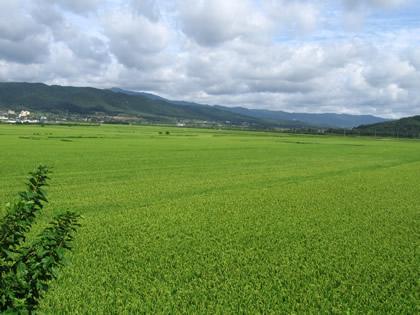How To Feed The Future? - A Promising Research on Rice
 |
| When thick Clouds are hanging on our Green Future , technology alone cannot guide us-above all is required - the Human Will to Survie and the Humanity feeling to Help Others |
At the current growth rate the global population is predicted to reach 10 billion by 2050. To feed this many people, food production worldwide will need to double during a period when climate change will worsen, fossil fuels will dwindle, and water availability will become unpredictable.
And in addition it is a well established fact that More than one billion people sleep with Empty Stomachs (A Hungry Planet Of Billion People) and more than 25000 people die from hunger-related causes. Sixty percent of the world’s population lives in Asia where each hectare of land used for rice production currently provides food for 27 people, but by 2050 that land will have to support at least 43 people.So it is definitely a challenge for humanity. But our history of existence says, we can fight it out.
700 million people in Asia currently depend on rice for the bulk of their calorific intake and it is predicted that during the next 40 years, rice production needs to increase by 50 per cent in order to feed the growing Asian population, whilst adapting to adverse changes in climate and water availability.So boosting the productivity of rice plants could be crucial as the world’s population continues to grow and water( and land) for growing crops becomes scarce.
The feasible solution to this chronic Mammoth problem seems in a new Research "C4" Rice - The initiative is led by the International Rice Research Institute (IRRI) and has received an $11m grant from the Bill & Melinda Gates Foundation. It is clear that the gains of the first Green Revolution are largely exhausted. Rice with C4 photosynthesis could make a major contribution to a second Green Revolution.
Joining this Initiative To tackle this problem, scientists in Oxford University’s Department of Plant Sciences are aiming to develop high-yield crop strains which will be better adapted to this climate-altered, resource-poor agricultural landscape of the near future . Professor Jane Langdale, Head of the Department of Plant Sciences, is engaged in the ‘C4 Rice’ project.
What is C4?
Photosynthesis converts carbon dioxide and the energy from sunlight into chemical energy and takes place in cell organelles called chloroplasts (wiki article). The chemical energy produced in these chloroplasts is then used by plants to live, grow, and in the case of crops, produce grain.
Conventional rice varieties use a standard photosynthesis pathway known as ‘C3’(wiki article), but under certain conditions, such as warmer temperatures, this pathway is inefficient. A number of plants, including maize, have evolved an extra photosynthesis pathway, called ‘C4’(wiki article), to solve this problem. The C4 photosynthesis pathway can increase efficiency by 50 per cent and iintroducing it into rice could provide the answer to Asia’s impending food problem.
Any Success?
The C4 Rice project is often quoted as being ‘highly ambitious’. In order to work, large changes need to be made to both the anatomy of rice leaves and the chemical reactions that take place inside them. However, there is encouraging evidence that it could be done.
The cost-benefit ratio of C4 rice is likely to be of the same order as the “dwarf-cultivars” produced in the first Green Revolution bringing benefits to hundreds of millions of people in the poorer parts of the world. Inserting the C4 photosynthetic pathway into rice should increase rice yield by 50%, double water-use efficiency, and use less fertilizer to achieve those improvements. No other evolutionary mechanism exists that could be added to C3 rice that could deliver that superior combination of benefits.
Poverty alleviation would be further magnified if the C4 syndrome were added to other C3 crops, such as wheat, growing in the hot countries of the developing world.
Jane’s(Head of the Department of Plant Sciences/Oxford)) work on the GLK genes suggests that they may play a role in regulating whether a plant’s chloroplasts use C3 or C4 photosynthesis. Ongoing work in her laboratory seeks to put GLK genes from maize, a naturally C4 crop, into rice plants. Once the cassette of genes controlling C4 photosynthesis are discovered it should be possible to either activate or introduce them into wheat and legumes cultivars used in sub-Saharan Africa.
Enough Focus?
Due to the unequal distribution of global wealth, the countries facing the most immediate problems do not have the funds to overcome them. Jane argues that to tackle food security there must be sustained funding and input from wealthy countries in order to bring about developing nation benefits. Liam points out that every day the same number of people die from malnutrition as from cancer, reflecting the bias of interest in developed countries. However, whilst scientific research alone cannot solve the issue of food security in the face of global politics, it is, says Jane, a very exciting time to be a plant scientist.
Links
- Department of Plant Sciences , Oxford will next year be launching a 21st Century Crops (Update- the project launced in 2010 and ended in 2015- the link has archived information) research initiative. This initiative seeks to found an Oxford Professorship in Crop Science and to encourage translational research, so that discoveries made about plant metabolism, growth and development can be transferred to agriculturally valuable crop plants.
- C4 Rice gets funding (External Link)
- A New Way to Cultivate Rice with Less Water and Fertilizer (SRI Technique)
- About Norman Borlaug ( The Man Behind Green Revolution)
